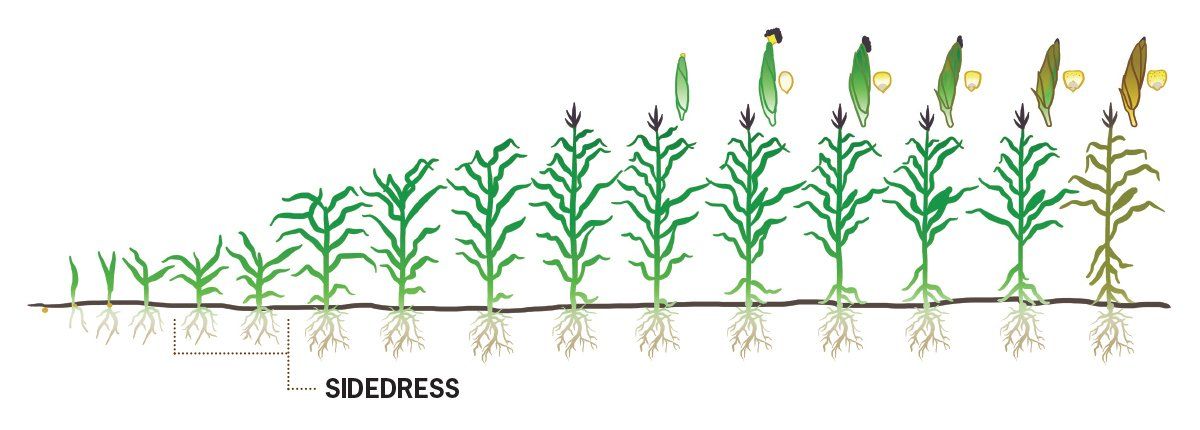The latest technologies for sidedress applications
Jenny Phillips, Marketing • May 18, 2020

Research averaged across hybrids and years has shown that corn needs only a small amount of its total nitrogen uptake prior to V6 growth stage. Nitrogen uptake (as well as potassium) begins to increase rapidly, so finding ways to improve nutrient use efficiency during this time is extremely important.
A corn plant also requires approximately 48% of its potassium between V6 and V12. Relying on moisture and diffusion to transport potassium to the root for ultimate uptake is a risky proposition at best. University trials validate that adding potassium to nitrogen solutions will improve nutrient use efficiency, improving yield response. By sidedressing with NACHURS Bio-K, corn farmers capitalize on the potassium-nitrogen synergy.
Humic acid can also enhance efficiency of sidedress nitrogen by enhancing root growth and phosphorus solubilization for greater nutrient and water uptake. It can create a biostimulant effect, promoting more vigorous, healthy plants.
NACHURS offers the latest technologies for sidedress applications:
High K Additive Bio-K Products
NACHURS K-fuse- An excellent alternative to potassium thiosulfate (KTS), NACHURS K-fuse offers the best source of premium potassium (NACHURS Bio-K), along with a boost of sulfur. NACHURS K-fuse is 3x more available in dryer soils with more nutrition supplied per acre. When applying 25 gal/ac or more of UAN the effective rate of NACHURS K-fuse is 4-5 gal/ac.
NACHURS K-flex- For growers applying 25 gal/ac or less of UAN, NACHURS K-flex provides the addition of potassium and sulfur during the critical growth stage. When applying 25 gal/ac or less of UAN NACHURS K-flex can be applied 1-1.5 gal/ac.
NEW! Humic Acid
NACHURS Humi-flex Max- The most concentrated humic acid on the market, NACHURS Hum-flex Max offers superior mixing with high K additive Bio-K products and UAN, ATS, KTS, and micronutrients. In 3rd party studies on corn NACHURS Humi-flex Max had a 87% win rate with a 14 bu/ac increase when applied with UAN.
When combining UAN + a high K additive Bio-K® product + NACHURS Humi-flex Max, you are setting your crop up for maximum yield potential.
Contact your NACHURS Sales Representative for more information.

We are at the point in the year where things are slowing down around the farm and it is time to reflect on the season to remind ourselves what we learned. Over the last couple of weeks, the District Sales Managers and I have spent some time reflecting on what worked well in the field and the challenges we faced too. Here are the top 5 things we learned from 2024 growing season: #1 Split applying Nitrogen and Sulfur is a practice that should be embraced on a yearly basis when growing corn. Do you remember how the planting season started and what happened in the first 60 days after the planters started rolling? Our field conditions started out dry with some areas of the corn belt showing up on the drought map. Then mother nature blessed us with rain that never stopped in some areas making it difficult to finish planting. Growers that had split applied their Nitrogen and Sulfur were able to avoid nutrient loss from the rain but also apply the nutrients when the crop needed it most. In the end yield was better on split applied nitrogen fields compared to fields that had all the N applied in the fall or spring before planting. #2 For the past 2 seasons in the North region, we have seen the benefits of adding NACHURS Humi-Flex FA to the in-furrow starter fertilizer. NACHURS Humi-Flex FA is our fulvic acid and it is becoming a valuable component in our starter fertilizer for many reasons. We are using it to chelate the nutrients in the starter fertilizer especially phosphorus. Humi-Flex FA also buffers the soil pH to neutral in that nutrient band keeping nutrients available in fields that have less then optimal pH for crop growth. Finally, we use Humi-Flex FA to create a healthy soil microbiome that leads to more root mass and nutrient uptake. #3 Nutrient uptake charts for corn and soybeans have been a great tool for our team to help our customers visualize the crops nutrient needs based on timing during the growing season.











